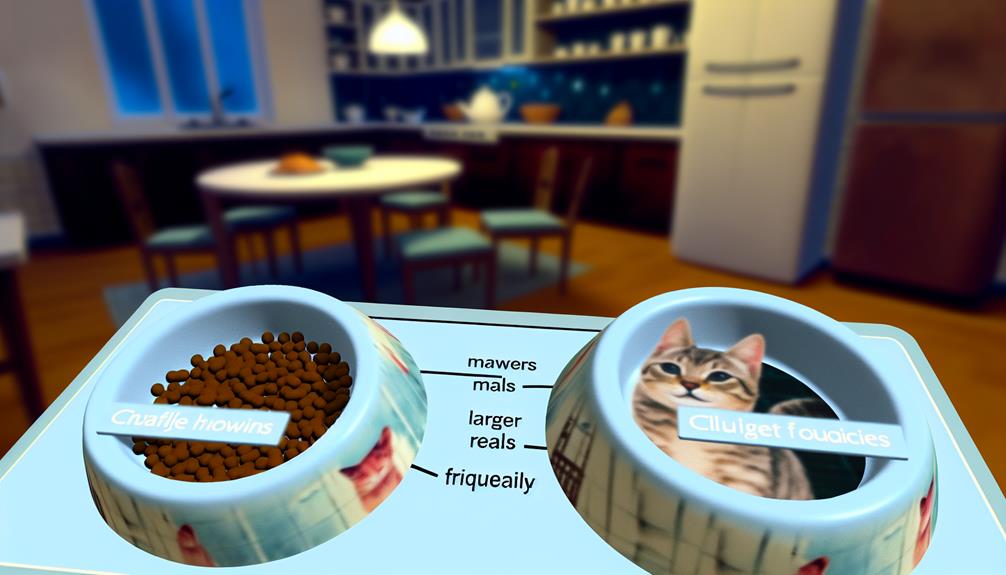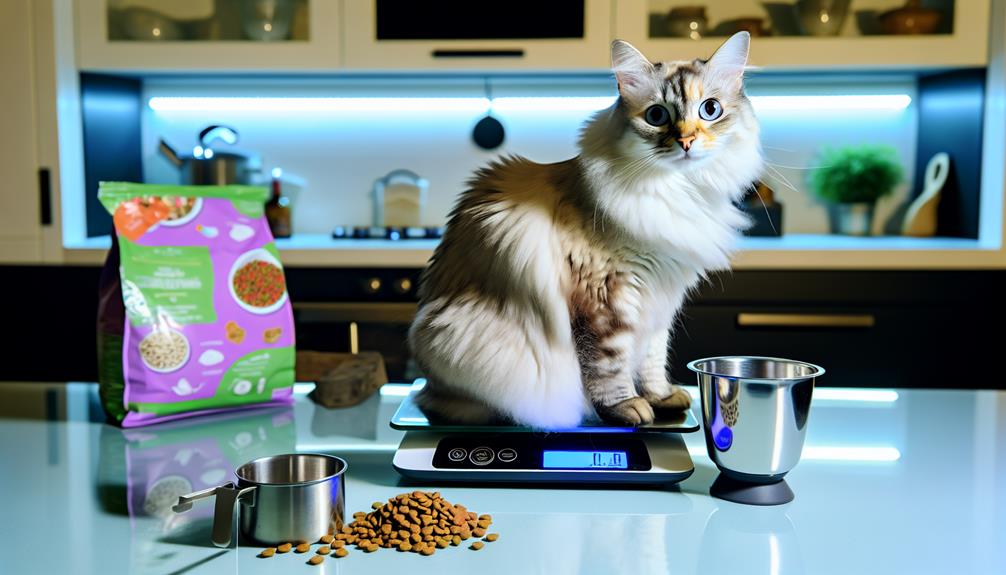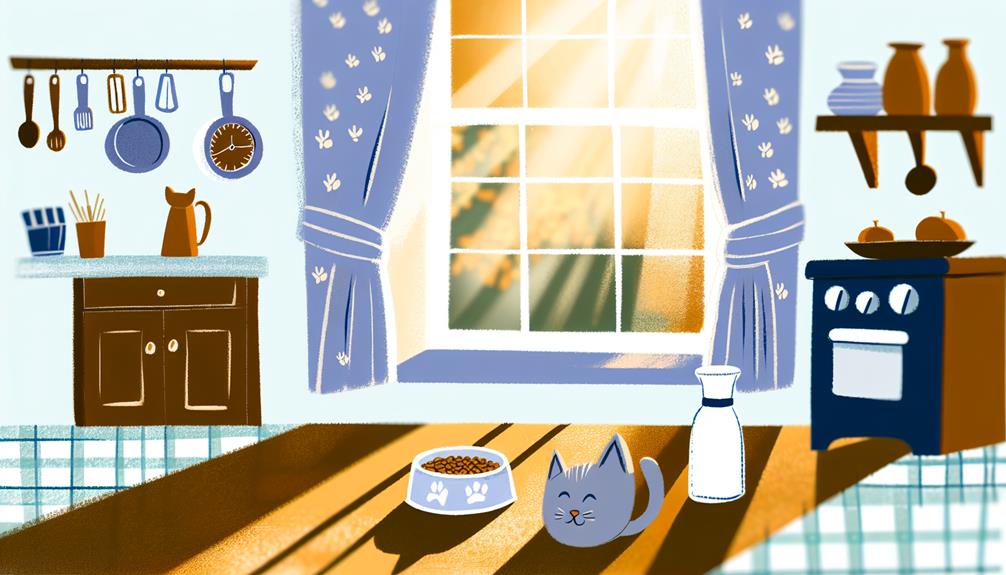Imagine your cat's sleek, agile body gracefully moving through your home, each motion reflecting their health and energy. Understanding how much to feed your feline friend can seem intimidating, but it's essential for maintaining their well-being. Factors like age, weight, and activity level all play significant roles in determining the correct portion sizes. Kittens, for instance, need nutrient-dense diets to support their rapid growth, while adult cats have different caloric requirements. To guarantee your cat gets the right balance of nutrients, you should consult feeding guidelines and perhaps seek veterinary advice. But what exactly do these guidelines entail?
Understanding Cat Dietary Needs
Understanding your cat's dietary needs is vital for their overall health and well-being. Cats are obligate carnivores, meaning their diet must consist primarily of meat. This requirement stems from their evolutionary biology, which has adapted them to derive necessary nutrients from animal tissues. A precise understanding of your cat's caloric requirements and nutritional balance is important in guaranteeing they remain healthy and active.
Caloric requirements for cats can vary considerably based on factors like age, weight, activity level, and metabolic rate. Typically, an adult cat needs about 20 calories per pound of body weight per day. For instance, a 10-pound cat would require approximately 200 calories daily. However, individual needs may vary, so it's important to monitor your cat's body condition and adjust their caloric intake accordingly.
Nutritional balance is another vital aspect of a cat's diet. A well-balanced diet should include high-quality proteins, moderate fats, and minimal carbohydrates. Cats require specific nutrients such as taurine, arachidonic acid, and vitamin A, which are found in adequate amounts only in animal-based proteins. Deficiencies in these essential nutrients can lead to severe health issues, including heart disease, vision problems, and compromised immune function.
When formulating your cat's diet, choose commercial cat foods that meet the Association of American Feed Control Officials (AAFCO) standards. These standards guarantee the food provides a balanced and complete nutritional profile. Alternatively, if you prefer a homemade diet, consult with a veterinary nutritionist to ensure all nutritional needs are met.
Factors Affecting Food Amount
When determining how much to feed your cat, several key factors come into play, each influencing their dietary needs. To begin with, your cat's activity level has a significant impact. Active cats, who engage in frequent play and exercise, require more calories compared to their sedentary counterparts. This is closely linked to their metabolic rate, which varies from cat to cat. A higher metabolic rate means your cat will burn calories faster, necessitating a larger food intake to maintain ideal body condition.
Age variations also play an important role. Kittens have different nutritional requirements than adult or senior cats due to their rapid growth and development. As cats age, their metabolism typically slows down, affecting their calorie needs. Health conditions are another vital factor. Conditions like diabetes, hyperthyroidism, or obesity require specific dietary adjustments to manage the ailment effectively.
Breed differences can't be ignored either. For instance, larger breeds like Maine Coons naturally require more food than smaller breeds such as Siamese cats. Additionally, some breeds are predisposed to certain health issues that necessitate specialized diets.
Environmental factors, such as the climate your cat lives in, can also influence their food requirements. Cats in colder environments may need more calories to maintain body temperature, while those in warmer climates might need less.
Understanding these factors will help you tailor your cat's diet to their specific needs, ensuring they receive the right amount of nutrients for their overall health and well-being. Always consult your veterinarian for personalized advice based on your cat's unique situation.
Feeding Kittens Vs. Adult Cats

Feeding a kitten differs markedly from feeding an adult cat, primarily due to their distinct nutritional needs. Kittens require more protein, fat, and certain vitamins and minerals to support their rapid growth and development. Their metabolic rate is considerably higher, necessitating a more nutrient-dense diet. Adult cats, on the other hand, need a balanced diet that maintains their weight and overall health, without the high caloric intake required for kitten growth.
For kittens, a well-structured feeding schedule is essential. You should feed them small, frequent meals—typically three to four times a day—until they are about six months old. This frequent feeding aligns with their high energy levels and helps maintain stable blood sugar levels. After six months, you can gradually shift to two meals per day. Always verify the food is formulated specifically for kittens, as it contains the essential nutrients they need for proper growth and development.
In contrast, adult cats are generally fed once or twice a day. The feeding schedule can be adjusted based on their activity level, age, and overall health. Some cats may thrive on free-feeding, where dry food is available at all times, but this method requires careful monitoring to prevent overeating, which can lead to obesity.
It's vital to regularly assess your cat's body condition and adjust the feeding amounts accordingly. Use precise measurements to avoid overfeeding, which is a common issue with both kittens and adults. By tailoring the feeding schedule and portions to your cat's specific life stage, you'll support their best health and well-being.
Choosing the Right Cat Food
As you determine how often and how much to feed your cat, selecting the right type of food is equally important to their health and well-being. The choice between dry vs. wet food is essential. Wet food typically contains higher moisture content, which can be advantageous for urinary tract health, especially in cats prone to urinary issues. However, dry food can be more convenient and better for dental health due to its crunchy texture.
When it comes to ingredient quality, look for options that list high-quality protein sources, such as chicken, beef, or fish, as the first ingredient. Avoid foods with excessive fillers, artificial preservatives, and by-products. Grain-free options are available and can be advantageous for cats with specific allergies or digestive issues, but it's important to ascertain these foods still meet all nutritional requirements.
Age-specific formulas are another important aspect to take into account. Kittens require higher protein and fat content to support their rapid growth and development, while adult cats need a balanced diet to maintain ideal health. Senior cats often benefit from formulas that address joint health, kidney function, and weight management.
It's advisable to consult your veterinarian for recommendations tailored to your cat's specific needs. Research indicates that cats thrive on diets that closely mimic their natural prey, which is high in protein and low in carbohydrates. Thus, a thorough analysis of the ingredient list and nutritional content is crucial in choosing the right cat food. By prioritizing ingredient quality and appropriate formulations, you'll greatly contribute to your cat's long-term health and well-being.
Monitoring and Adjusting Portions

Making sure your cat receives the correct portion sizes is vital for maintaining a healthy weight and overall well-being. To achieve effective portion control, you'll need to take into account your cat's age, weight, activity level, and any specific health conditions. Start by consulting the feeding guidelines on your cat food's packaging, but remember, these are generalized recommendations. Each cat is unique, so adjustments might be necessary.
Monitoring your cat's weight is the first step in fine-tuning their diet. Weigh your cat monthly and keep a record. Subtle changes can indicate whether you need to adjust portion sizes. If your cat is gaining weight, reduce their daily intake slightly. Conversely, if they're losing weight or appear underweight, increase portions incrementally. Aim for gradual changes to avoid any digestive upset.
Feeding schedules play an important role in portion control. Consistent feeding times help regulate your cat's metabolism and prevent overeating. Most adult cats do well with two meals per day, while kittens may require more frequent feedings. Use a kitchen scale or measuring cup to guarantee accuracy, as "eyeballing" portions often leads to overfeeding.
Incorporate regular physical activity into your cat's routine. Play sessions not only provide exercise but also help you gauge their energy needs. A sedentary cat will require fewer calories than an active one. If your cat has specific health issues, such as diabetes or obesity, work closely with your veterinarian to tailor a diet plan that meets their needs.
Conclusion
Imagine your cat's sleek, shiny coat and bright, curious eyes, a reflection of their well-balanced diet. By understanding their dietary needs and adjusting portions based on their age, weight, and activity level, you're ensuring they thrive. Look to feeding guidelines, consult with your vet, and choose nutrient-rich foods. Regular monitoring and adjustments will keep them healthy and happy, making every purr and playful leap a rewarding confirmation of your expert care.
